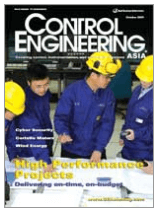 Emerson’s Jonas Berge added a comment to a post, Mass Flow Measurement for Fuel Gases. In his comment, he pointed to a Control Engineering Asia article, Time for Calibration?, that he had written a couple years ago. In the article, Jonas explains how advanced diagnostics technology can help determine if a Coriolis flowmeter needs to be removed from the process or if it can wait.
Emerson’s Jonas Berge added a comment to a post, Mass Flow Measurement for Fuel Gases. In his comment, he pointed to a Control Engineering Asia article, Time for Calibration?, that he had written a couple years ago. In the article, Jonas explains how advanced diagnostics technology can help determine if a Coriolis flowmeter needs to be removed from the process or if it can wait.
Jonas opened with a great description of Coriolis measurement theory of operation:
A Coriolis flowmeter sensor consists of one or two tubes through which the fluid flows. A control circuit drives electric coils applying an oscillating force to the tubes moving them from side to side maintaining amplitude at its resonant frequency. As fluid passes through the tubes, they twist slightly due to the Coriolis effect. The amount of tube deflection is directly proportional to the mass flow and is registered as a phase shift from which the mass flow is calculated.
He notes that this Coriolis effect can also be used to measure density, that it can measure gases and liquids, and measurements are:
…largely unaffected by changes in temperature, pressure, density, viscosity, and flow profile. They also have high accuracy and repeatability.
If abrasive or corrosive fluids are being measured, the walls inside the Coriolis flowmeter sensor can thin, causing a change in stiffness. This process can cause the sensor’s calibration to drift. Jonas noted issues with calibration:
…too frequently is costly, is time consuming, and disrupts the production process. But if calibrating is not done often enough, product quality can be negatively impacted.
He highlighted the optimum solution:
…in-situ meter verification, a form of diagnostics by which the complete performance of a Coriolis flowmeter is verified. Electronics determine whether a Coriolis flowmeter has experienced a change in stiffness due to corrosion, erosion, or deformation.
…measured stiffness is compared to the original stiffness when the Coriolis flowmeter left the factory to determine if the structure of the sensor tubes has changed or been damaged in any way. Multiple test frequencies are used to keep the diagnostics independent of density and flow and thus can be performed on any process fluid; it need not be the same fluid as in the factory benchmarking.
This Micro Motion smart meter verification is embedded in the Coriolis flowmeter. This in-situ verification can be done remotely due to digital communications protocols such as HART, Foundation fieldbus, and WirelessHART along with electronic device description language (EDDL – IEC 61804-3). Jonas described how it works:
…EDDL wizards created by the flowmeter manufacturer guide the technician step-by-step; no specialized training is required to perform meter verification. Percent completion is displayed throughout the process so technicians know how much longer they need to wait.
The meter verification wizard makes this a simple pass or fail test, it does not present incomprehensible numerical values or charts that need interpretation, but rather offers actionable information.
In addition to verification, Jonas described abnormal situations that could be detected:
…advanced Coriolis flowmeters now have diagnostics that can detect and report bubble or slug flow to both operators and maintenance technicians directly at their workstations.
Give the article a read if you are using or looking into using Coriolis flow and density measurement in your process.




